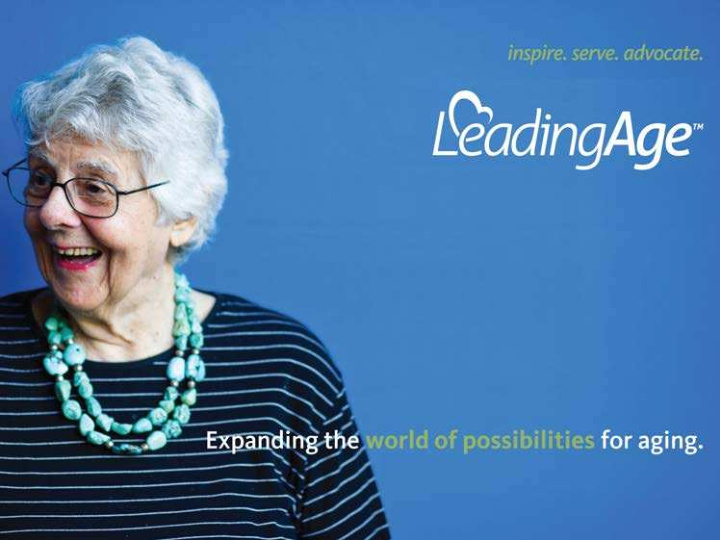



Ex panding t h e wor ld of possibilities for aging.
Senior Housing as We “Know” It: • “Active” Senior Housing • Supportive Senior Housing • Assisted Living • Nursing Homes • Continuing Care Retirement Communities
The Field Of Aging Services Is Evolving Spectrum of Services Need driven Want driven Preventative Long-term care Hospital Active adult Continuing care retirement communities/multi-level campus communities Board & Care Intentional Acute Geriatric Assisted Outpatient Intermediate Care Community Hospitalization Health Assessment Living Therapies Telehealth Senior & Wellness Subacute Respite Palliative & Home Membership Centers Rehab Care Care Technologies Wellness Independent Day Care Home Health Long Term Acute Programs Living Hospice Dementia Hospitalization Community Assisted Case/Disease Personal Skilled Diagnostic Based Living Management Care Assistance Nursing Care & Treatment Services Center Housing w/ Services Medical Social Skilled LTC Source: Adapted from previous Greystone and LarsonAllen LLP presentations
Senior Characteristics Based on Housing Homeowners: Living in Assisted Housing: Most seniors (almost 80%) are Growing older and more frail homeowners Twice the prevalence of disability 50% of senior homeowners are as their home owner over age 75 and 12% are over age counterparts 85 One-third have difficulty with Age, frailty and disability go hand routine activities in hand 12% have cognitive impairments 8% of seniors under age 75 (renters and home owners) are Almost 40% of older Section 202 disabled and 50% over age 85 are residents are over age 80 disabled A 1999 survey estimated that 30% of Section 202 residents transferred to a nursing home
The 2012 MetLife Market Survey of Nursing Home, Assisted Living, Adult Day Services, and Home Care Costs The national average daily rate for a private room in a nursing home is • $248, while a semi-private room is $222 up from $239 and $214 respectively in 2011. • The national average monthly base rate in an assisted living community rose from $3,477 in 2011 to $3,550 in 2012. • The national average daily rate for adult day services remained unchanged from 2011 at $70 in 2012. • The national average: hourly rates for home health aides ($21) remained unchanged, while the homemaker hourly rate increased by 5.3% from $19 in 2011 to $20 in 2012.
Demographics Define the Market Projected U.S. Seniors Population (2010 to 2050) 5 Year Increments 100,000 90,000 80,000 70,000 (In Thousands) 60,000 50,000 40,000 30,000 20,000 10,000 0 2010 2015 2020 2025 2030 2035 2040 2045 2050 65 Years & Over 75 Years & Over 85 Years & Over 100 Years & Over 6 Source: U.S. Census Bureau National Population Projections (released 2008, based on Census 2000)
U.S. Disability Trends Percentage of Adults Ages 6 5 and Older w ith Disabilities, 2 0 0 0 -2 0 4 0 Source: “Meeting the Long-Term Care Needs of the Baby Boomers: How Changing Families Will Affect Paid Helpers and Institutions,” Johnson, Richard W., Toohey, Desmond and Wiener, Joshua M., May 2007. 7
Emerging Models of Housing and Services • Expansion of HCBS, offering more flexibility • CCRC and skilled nursing offering community services • Program of All Inclusive Care for the Elderly (PACE) • Small house models for care settings • Co-housing • Village networks • Affordable housing with services • Promoting deinstitutionalization • Facilitating nursing home diversion programs • Better managing dual eligibles • State Driven Innovation • Service Coordination
Major Obstacles to an Evolving Senior Housing Market Not all providers or policy makers will buy into the concept of aging- in-place Inability for federal, state and local agencies covering a myriad of issues to work together Licensing/regulation Liability Fair housing laws Difficulty bridging housing and aging services Resources Limited understanding/capacity of many housing providers Resident opposition Affordability
Contact information: Alayna Waldrum, Esq. Legislative Representative awaldrum@leadingage.org (202) 508-9476
Recommend
More recommend